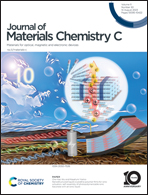A nonbenzenoid acepleiadylene derivative with small band gap for near-infrared organic phototransistors†
Abstract
Near-infrared (NIR) materials have attracted intensive attention in recent years. In this paper, we design a new nonbenzenoid acepleiadylene derivative (APD-DPP) with NIR absorption by taking advantage of the narrow band gap of acepleiadylene. Experimental and theoretical studies show that APD-DPP has strong NIR absorption and a high carrier mobility of up to 0.30 cm2 V−1 s−1. NIR phototransistors based on APD-DPP exhibit a high photoresponsivity of 1.30 A W−1, a photosensitivity of 1.34 × 104, and a specific detectivity of 5.31 × 1011 Jones. These results reveal the potential of APD as a building block for NIR-absorbing materials.

- This article is part of the themed collections: 2023 Journal of Materials Chemistry C HOT Papers and Journal of Materials Chemistry C Emerging Investigators


 Please wait while we load your content...
Please wait while we load your content...